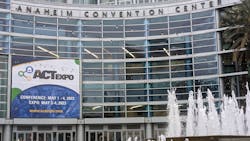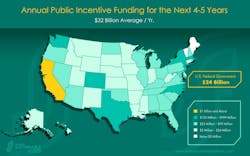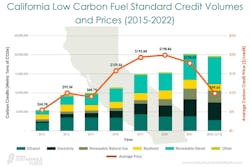‘Sunset of the Diesel Era’ is upon us, study finds
ANAHEIM, California—The Diesel Era is ending, but it won't be easy for fleets. However, public policy and financial and other incentives are pushing transportation into a cleaner future, according to the fourth State of Sustainable Fleets Market Brief, which also notes that transitioning to new power technologies faces financial and supply hurdles.
"It's no surprise that one of the findings is that we're starting to hear folks talk about the sunset of the Diesel Era," said Erik Neandross, chief executive of Gladstein, Neandross & Associates, which produced the annual study. "We believe that 2027 could very well be the last of the major diesel engine development programs that we see out there in the world—which is pretty amazing."
Last year, Navistar said its new S13 Integrated Powertrain includes the final internal combustion engine the producer of International Trucks will develop. Navistar and other major North American OEMs have some zero-emission trucks and goals to develop and expand those ZE offerings. Regulators also are pushing OEMs and engine-makers to find cleaner ways to move goods and people in the coming years.
See also: Why diesel still matters
The 2023 report from clean technology consultants GNA was released on the opening day of the firm's Advanced Clean Transportation Expo, which drew another record crowd to Orange County. Organizers said about 13,000 people are attending the show, a 50% increase from 2022.
"Of course, the record attendance that we have here is really indicative of the growth and investment that we've seen in the clean fuels and fleet industry in the last couple of years," Neandross said during a main stage presentation on May 1 in front of thousands of fleet and transportation executives.
The State of Sustainable Fleets report shows a future where new diesel engine development programs slow as zero-emission vehicles become the centerpiece of regulations in states representing about half of the U.S. economy.
Nearly 80% of air pollutants come from "mobile sources. That's why clean transportation technologies are so important," Wayne Nastri, South Coast Air Quality Management District executive officer, said on May 1. "They're so needed in order for us to meet not only federal and state air-quality standards—as well to reduce some of the toxic emissions and the climate pollutants—but the key is that we need to transition to zero-emission as quickly as possible."
"Continuous innovation and deployment of the cleanest technologies for all transportation sectors—including off-road equipment, trucks, ships, locomotives—is needed to reach the aggressive state and federal air quality standards," Nastri added.
He said that his group's 2022 Air Quality Management Plan, which sets the path toward decarbonization here in Southern California, relies on the equipment and technology on display at ACT Expo this week. "Over the last 25 years, we've come a long way," he noted. "More than 30,000 vehicles and equipment have been incentivized and upgraded with cleaner equipment."
A cleaner future is 'hard'
The past 18 months have laid the roadmap for a zero-emission future in many states and produced early signals that the era of the diesel engine, the workhorse of the freight industry, is being squashed by these regulations in California and nationally.
"Regulation is a big deal," Neandross said. "The regulations are out there pushing to make diesel engines much cleaner—but also likely more expensive and more complicated."
See also: Daimler enters medium-duty EV race with Rizon brandThe U.S. Environmental Protection Agency's Clean Truck rule requires an 80% reduction in NOx emissions from commercial vehicles in 2027. Phase 3 of the federal Greenhouse Gas Standards for Heavy-Duty Vehicles focuses on lowering CO2 emissions.
"Of course, California always has to have its own rules," added Neandross, whose firm is based in the Golden State. "We have a really low NOx omnibus rule, which was adopted by the [California] Air Resources Board. And, assuming EPA grants the waiver that I know is under development as we speak, that will begin in 2024. Then in 2027, that will require a 90% reduction in the NOx emissions from heavy-diesel engines."
On top of the reduced emissions standards, the regulations require increased warranties on cleaner equipment. "So, getting to these super low emissions levels that are going to be required is going to be difficult," Neandross said. "It's going to require a lot of investment."
Neandross said the requirements could add about $30,000 to the cost of new diesel tractors. "To produce these engines and super low emission levels, and then warranty them out to 600,000 miles and then maintain them—it's going to be hard, it's going to be expensive," he added.
Past State of Sustainable Fleets reports found that some clean fuels and vehicles are superior to gasoline- and diesel-fueled vehicles for select fleet applications. As a result, the interest and adoption of renewable fuels and advanced technology drivetrains are accelerating across the industry.
"ZEVs and other alternative powertrains, infrastructure, renewable energy, and funding all continue to make significant strides in meeting and exceeding fleet sustainability targets," Drew Cullen, Penske's senior VP of fuels and facility services. "This year's report highlights the growing investments and innovations OEMs, energy providers, public and private fleets, and government agencies are making in developing, experimenting, and adopting clean transportation technologies."
State of Sustainability highlights
Here are some highlights and analyses into the alternative fuels and clean transportation markets found in the report, which can be downloaded at StateofSustainableFleets.com:
- The federal government and California have adopted rules requiring an 80% reduction in NOx emissions from diesel engines, adding tens of thousands of dollars to the cost of new diesel engines and likely requiring additional ongoing maintenance.
- More than $32 billion per year, on average, in public incentive funding for clean vehicles and infrastructure will be available for the next four to five years.
- Thirteen states and the District of Columbia have passed or are considering some form of California's ZEV sales mandate on manufacturers. These same states are expected to consider California's ZEV purchase mandate on fleets that passed last week.
- U.S. renewable diesel production doubled from 2021 to 2022 to 800 million gallons, and renewable natural gas replaced nearly all fossil natural gas in California transportation for the second year in a row.
- In 2022, compressed natural gas averaged $2.73 per diesel-gallon-equivalent, and propane averaged $2.10 per-gasoline-gallon equivalent compared to an average of $5.78 per gallon and $4.79 per gallon for diesel and gasoline, respectively.
- Orders for medium- and heavy-duty battery-electric vehicles surged 640%, with nearly 30,000 medium-duty orders and 2,400 heavy-duty battery-electric school bus orders in 2022.
- At least half of fleets across 11 different fleet types, including logistics, transit, school, cargo, and delivery fleets, have operated a medium- or heavy-duty battery-electric vehicle in the annual survey, and 92% of those fleets plan to grow their use.
- Supply chain disruptions have raised the price of medium- and heavy-duty battery-electric vehicles and delays in electrical service have caused multiyear delays for some deployments.
- The public hydrogen station network grew 12%, and the first plans to build station networks outside of California were announced for the central, mid-Atlantic, and southwestern U.S.
Daimler Truck North America, Penske Transportation Solutions, and Shell are title sponsors of the 2023 report; Dana is a supporting sponsor.
About the Author
Josh Fisher
Editor-in-Chief
Editor-in-Chief Josh Fisher has been with FleetOwner since 2017. He covers everything from modern fleet management to operational efficiency, artificial intelligence, autonomous trucking, alternative fuels and powertrains, regulations, and emerging transportation technology. Based in Maryland, he writes the Lane Shift Ahead column about the changing North American transportation landscape.



